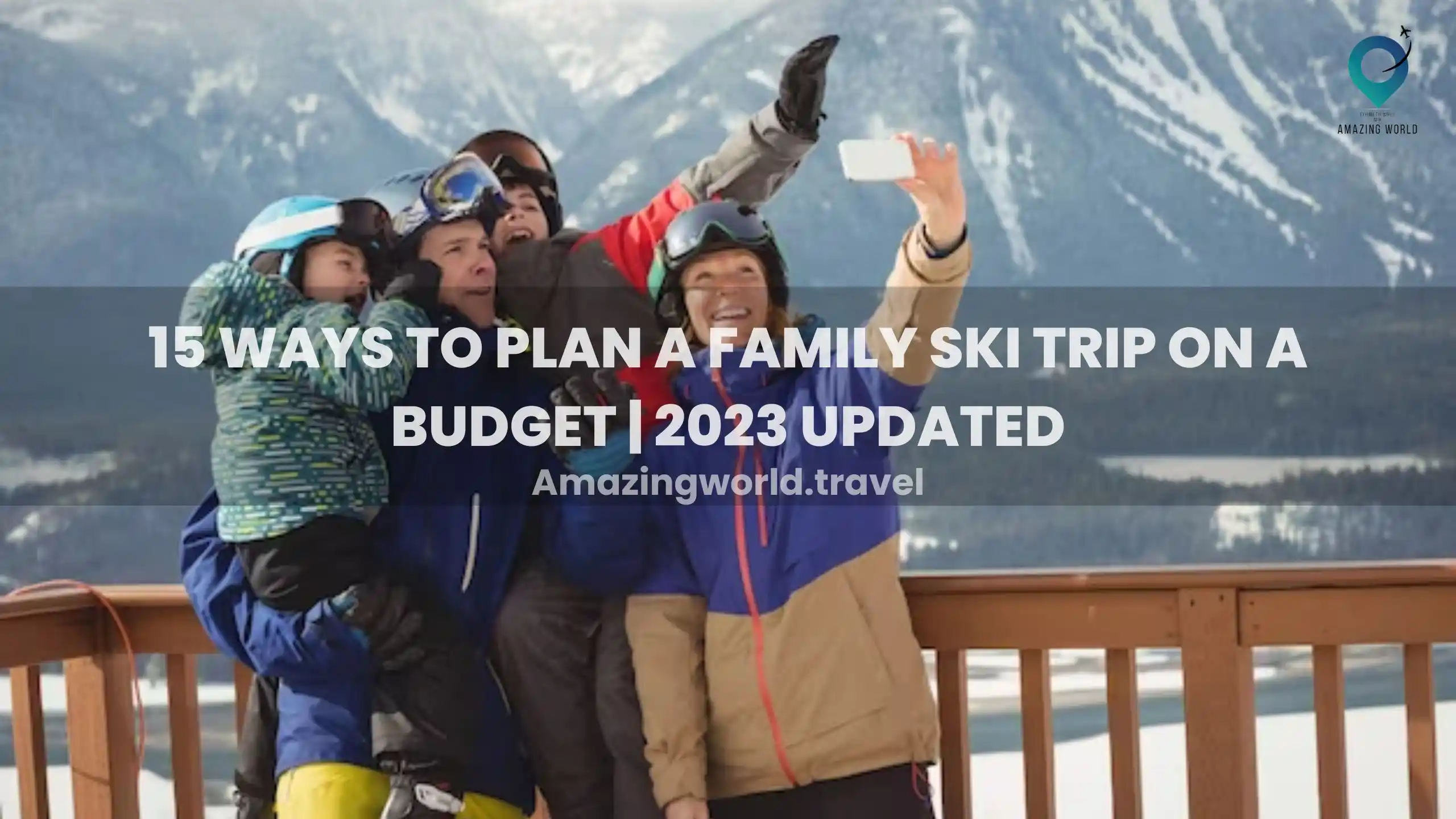How to Plan a multigenerational trip | Best Tips (2023 Updated)

Are you gearing up for an unforgettable adventure that spans generations? Planning a multigenerational family trip can be an exhilarating yet complex endeavor, entailing a blend of logistics, considerations, and joyful anticipation. Embarking on a journey that caters to the varied tastes, needs, and interests of different family members is no small feat. However, fear not! This ultimate guide is your compass, navigating through the intricacies of orchestrating a seamless multigenerational expedition.
As you embark on this exciting venture, envision picturesque destinations and shared moments that transcend age barriers. This journey is more than just visiting new places; it’s about crafting cherished memories that bridge the generational gap. Within these pages, discover tips and strategies tailored to curate an experience where every family member feels included, every smile counts, and every memory is etched in the heart.
From managing accommodation logistics to ensuring everyone’s comfort, from exploring novel activities together to respecting personal space, this guide is your roadmap to weaving an unforgettable tapestry of moments. Delve into the art of creating inclusive dining experiences, setting expectations for togetherness, and cherishing post-trip reflections that keep the adventure alive long after the journey ends.
“If you are looking for the best hotel and flight deals for your next vacation, then we recommend booking your bundled flight and hotel through hotwire.com.“
Essential Considerations for Multigenerational Travel

Multigenerational travel sounds like herding cats at times, doesn’t it? But fear not, as I’m here to sprinkle some wisdom on this delightful chaos. Now, let’s break down the essential considerations for planning a multigenerational trip because, trust me, you don’t want Granny frowning at you for forgetting her favorite tea bags!
- Age-Appealing Destinations: Consider places that cater to various age groups. While Grandpa might be thrilled with a historical tour, the teenagers might yawn their way through it. Mix it up with a balance of adventure, relaxation, and educational spots.
- Activity Allotment: Picture this: The kids demand a water park, Grandma desires a serene museum, and Uncle Joe wants to test his limits on skydiving. Blend activities that cater to everyone’s interests. Pro tip: A scavenger hunt is a winner across generations!
- Logistics Masterplan: Booking accommodations for a large, diverse group needs ninja-level skills. Ensure lodging is comfortable and accessible, and, most importantly, doesn’t require Grandpa to hike five flights of stairs. Accessibility matters!
- Budgeting Diplomacy: Money talk? Absolutely! Set clear expectations regarding expenses. Discuss who covers what, from the big-ticket items to the ice cream cones. Nobody wants a financial feud on vacation!
- Travel Timing: Avoid peak travel seasons if you can. Not only will it save you some bucks, but it also means less elbow-jostling at tourist spots. Patience is a virtue, but avoiding crowds is a blessing!
- Health and Safety Priority: Grandma’s dietary restrictions, Dad’s allergies, and the baby’s nap schedule are crucial. Plan and have a medical kit handy because bumps, bruises, and the occasional tummy upset are inevitable.
- Personal Space Preservation: Even the closest families need a breather. Whether it’s downtime in separate rooms or a quiet solo stroll, ensure there’s ample space for everyone to recharge.
- Communication is Key: Talk. Listen. Repeat. Communication is your secret sauce. Discuss expectations, interests, and potential conflicts beforehand. It might save you from a ‘heated’ debate over the best dinner spot.
- Flexibility and Fun: Plans are great until they aren’t. Be ready to pivot. Some of the best moments happen when plans go haywire. Embrace spontaneity – it’s where the real adventure hides!
Remember, the key to a successful multigenerational trip is flexibility, patience, and a pinch of humor. Statistics might say something, but the memories you create together will speak volumes. So, pack your sense of adventure and let the multigenerational escapade begin!
Choosing a Destination Catering to Varied Age Groups
- Theme Parks & Entertainment Complexes: Destinations like Orlando (Disney World, Universal Studios) or similar entertainment hubs offer a spectrum of attractions for all ages, from thrill rides for teens to character meet-and-greets for the little ones and serene areas for grandparents.
- National Parks: Nature has its way of captivating everyone. Places like Yellowstone or Grand Canyon offer breathtaking views, easy walks for grandparents, hiking trails for the more adventurous, and educational programs for kids.
- Cultural Cities: Cities rich in history and culture, such as Rome, Kyoto, or Paris, provide diverse experiences. There are museums, historical sites, walking tours, and delightful cafes that cater to various interests and ages.
- Beach Resorts: Sandy Shores are universal crowd-pleasers. Beach destinations offer relaxation for grandparents, water activities for the young ones, and strolls or beach sports for everyone else.
- Cruise Ships: Floating cities on the water! Cruises provide a mix of entertainment, dining, and activities suitable for different age groups, ensuring there’s always something exciting to do.
Activities to Engage Different Generations

- Cooking Classes or Food Tours: Learning to cook local dishes or exploring culinary delights is an engaging activity for all ages. Everyone loves food, right?
- Outdoor Adventures: Zip-lining, kayaking, or even nature walks can be thrilling yet adaptable activities suitable for various physical abilities.
- Arts and Crafts: Pottery-making, painting, or craft workshops can be enjoyable and provide opportunities for creative expression for kids and adults alike.
- Cultural Experiences: Visiting historical sites, attending local festivals, or watching cultural performances offers an educational and entertaining experience for the entire family.
- Team Challenges or Games: Scavenger hunts, board games, or team challenges are fun ways to encourage bonding and friendly competition across generations.
Managing Accommodation Logistics for Large Groups
When orchestrating accommodations for a multigenerational excursion, handling a large group’s needs and preferences demands strategic planning and meticulous attention to detail.
- Space and Accessibility: Opt for lodging that offers ample space to accommodate everyone comfortably. Ensure there are accessible rooms or facilities for elderly members or anyone with mobility challenges.
- Multiple Bedrooms and Bathrooms: Large groups mean varied routines. Look for accommodations featuring multiple bedrooms and bathrooms to accommodate different sleep schedules and personal needs.
- Common Areas and Amenities: Common spaces like a spacious living room, dining area, or backyard can foster family togetherness. Facilities like a well-equipped kitchen, laundry, and entertainment options can enhance the stay.
- Location and Proximity: Choose a location central to the activities planned. Consider nearby amenities, attractions, and transportation options to simplify logistics and minimize travel time.
- Booking in Advance: Large group accommodations tend to get booked quickly. Plan and book well in advance to secure the best options and negotiate group rates or discounts.
To ensure a seamless experience for everyone, the choice of accommodation plays a pivotal role. It’s about finding the sweet spot between comfort, convenience, and functionality for a memorable stay.
Streamlining Travel Logistics for Multigenerational Vacations
Smooth travel logistics are the backbone of a successful multigenerational trip. Coordinating transportation and managing the travel process can significantly impact everyone’s experience.
- Transportation Arrangements: Choose transportation options that accommodate the entire group comfortably. Whether it’s air travel, train rides, or road trips, ensure everyone’s needs are met, especially for long journeys.
- Travel Itineraries and Schedules: Create a well-organized itinerary that accounts for different age groups’ needs and preferences. Incorporate breaks, rest stops, and travel activities suitable for various energy levels.
- Baggage and Luggage Management: With a large group, managing luggage becomes crucial. Advise everyone to pack efficiently and consider transportation limitations for hassle-free travel.
- Travel Documents and Essentials: Ensure everyone has the necessary travel documents, medications, and essentials. It’s vital to have a checklist to avoid last-minute rushes or missing items.
- Emergency Plans: Unexpected situations may arise. Establish contingency plans for medical emergencies, unexpected delays, or any unforeseen circumstances.
Efficient travel logistics streamline the journey, ensuring everyone arrives at their destination comfortably and with minimal stress, setting the stage for an enjoyable vacation together.
Ensuring Comfort and Enjoyment for All Family Members
Creating an environment where every family member feels comfortable and engaged is fundamental for a successful multigenerational trip.
Ways to Enhance Comfort and Enjoyment:
- Flexibility in Activities: Offer a mix of activities catering to various interests and physical capabilities. Balance adventurous outings with leisurely options and downtime for relaxation.
- Respecting Individual Preferences: Acknowledge and accommodate individual preferences. Whether it’s dietary needs, preferred activities, or personal space, respecting these preferences fosters a harmonious atmosphere.
- Open Communication: Encourage open dialogue among family members. Allow everyone to voice their opinions and contribute to the trip planning. Address concerns and find compromises if needed.
- Prioritize Safety and Well-being: Safety is paramount. Ensure the environment is safe for all ages, adhere to health guidelines, and have first aid kits handy for any emergencies.
- Encourage Bonding Moments: Plan activities that encourage bonding and interaction among family members. Shared experiences create lasting memories and strengthen family connections.
Creating an environment that prioritizes everyone’s comfort, preferences, and enjoyment contributes significantly to the overall success and satisfaction of a multigenerational trip.
Effective Communication and Coordination in Trip Planning
Communication is the glue that holds a multigenerational trip together. Efficiently coordinating plans and maintaining clear communication channels is pivotal.
Strategies for Effective Communication:
- Establish a Planning Committee: Designate a core team responsible for trip planning and decision-making. This ensures a structured approach and streamlines communication.
- Regular Family Meetings: Schedule meetings or video calls to discuss trip details, expectations, and any concerns. Keep everyone in the loop to maintain transparency and clarity.
- Utilize Technology: Embrace communication tools like group chats, shared documents, or trip-planning apps. These tools facilitate real-time updates, itinerary sharing, and collaboration among family members.
- Delegate Responsibilities: Assign specific tasks to different family members according to their strengths or interests. This promotes involvement and a sense of ownership in the trip-planning process.
- Be Flexible and Accommodating: While having plans is essential, be open to suggestions and changes. Flexibility in communication and planning ensures everyone feels heard and valued.
Budgeting and Expense-Sharing Strategies
When organizing a multigenerational trip, establishing clear budgeting and expense-sharing strategies is pivotal to preventing financial stress and foster harmony among family members.
Effective Budgeting Strategies:
- Open Discussions: Initiate conversations about the overall budget early on. Discuss everyone’s financial comfort zones and set realistic expectations.
- Shared Expenses: Outline shared expenses such as accommodations, meals, and transportation. Consider using apps or spreadsheets for transparent expense tracking.
- Group Discounts and Deals: Leverage group discounts or travel deals when booking accommodations, tours, or activities. Group bookings often yield cost savings.
- Individual Budgets: Allow flexibility for personal expenses. Some family members might prefer higher-end dining or additional activities, so allocate space for individual budgets within the overall plan.
- Emergency Fund: Have a contingency budget for unexpected expenses or emergencies. It’s wise to set aside a portion of the budget for unforeseen circumstances.
Implementing these strategies ensures financial transparency and fairness, allowing everyone to contribute comfortably and enjoy the trip without financial strain.
Incorporating Downtime and Flexibility in Itineraries
Balancing a structured itinerary with downtime and flexibility is key to accommodating various energy levels and interests among different generations during a trip.
Strategies for Downtime and Flexibility:
- Scheduled Rest Periods: Integrate scheduled breaks or free periods in the itinerary. Allow time for relaxation or personal exploration.
- Optional Activities: Offer optional activities for different time slots. This gives individuals the freedom to choose activities aligned with their preferences.
- Flexibility in Plans: Be open to spontaneous changes or additions to the itinerary. Sometimes the most memorable experiences arise from unplanned moments.
- Mindful Scheduling: Avoid overpacking the schedule. Leave ample time between activities to accommodate unforeseen delays or simply allow for a slower pace.
- Respect Individual Needs: Understand and respect different energy levels and interests within the group. Encourage self-care and downtime when required.
By incorporating downtime and flexibility into the itinerary, you create a balanced trip that caters to both structured activities and personal preferences, ensuring everyone finds moments of relaxation and enjoyment.
Catering to Health Concerns and Special Needs
Considering health concerns and special needs within a multigenerational group is crucial to ensuring a safe and comfortable travel experience for all.
Considerations for Health Concerns and Special Needs:
- Medical Preparations: Discuss any medical conditions or dietary restrictions before the trip. Ensure necessary medications and medical supplies are packed.
- Accessible Accommodations: Opt for accommodations that cater to specific needs, such as wheelchair accessibility or rooms with handrails for elderly members.
- Adaptable Itineraries: Plan activities that accommodate various physical abilities. Ensure there are options for both leisurely and more active pursuits.
- Dietary Considerations: Take into account dietary restrictions or preferences when planning meals. Opt for restaurants with diverse menus to cater to different dietary needs.
- Emergency Preparedness: Familiarize yourself with local medical facilities or pharmacies at the destination. Have emergency contacts and insurance information readily available.
Creating Inclusive and Enjoyable Dining Experiences
Dining experiences during a multigenerational trip can be a fantastic way to bond, share stories, and savor local cuisine. Crafting inclusive dining experiences requires attention to preferences and dietary needs, and creating an atmosphere where everyone feels comfortable.
Strategies for Inclusive Dining:
- Varied Dining Options: Choose restaurants or venues offering diverse menus to accommodate different dietary preferences and restrictions, including vegetarian, vegan, or gluten-free options.
- Family-Style Meals: Opt for family-style dining to encourage sharing and sampling various dishes. It promotes interaction and allows everyone to try different foods.
- Special Dining Events: Consider organizing special dining events like a themed dinner night or a local cooking class. It adds a fun element and provides an opportunity for everyone to participate.
- Advance Reservations: Make reservations in advance, especially for larger groups, to ensure a smoother dining experience and minimize wait times.
- Flexibility in Dining Times: Be mindful of different eating schedules. Offer flexibility in dining times to accommodate early birds or those who prefer later meals.
By selecting dining options that cater to diverse tastes and dietary needs while fostering an inclusive and communal atmosphere, you create memorable experiences around food for everyone involved.
Setting Expectations and Boundaries for Togetherness
Maintaining harmony and understanding the boundaries of togetherness is crucial for a multigenerational trip, where various personalities and preferences come together.
Ways to Set Expectations and Boundaries:
- Family Meetings: Have open discussions about expectations for togetherness. Address the balance between group activities and personal time.
- Define Personal Time: Encourage individuals to communicate their need for personal space or downtime without feeling guilty. Respect these boundaries and schedule breaks accordingly.
- Agree on Group Activities: Determine specific group activities but allow for individual choices within the schedule. Ensure everyone has input into the itinerary.
- Communication is Key: Encourage open communication about preferences and boundaries. Discuss any potential conflicts before they escalate and find compromises.
- Be Flexible and Understanding: Understand that everyone has different comfort levels and needs for togetherness. Flexibility and empathy go a long way in maintaining harmony.
Setting clear expectations for togetherness, respecting personal boundaries, and fostering open communication ensures a balance between shared experiences and individual autonomy during the trip.
Respecting Privacy and Personal Space
Respecting privacy and personal space is vital in ensuring everyone feels comfortable and at ease, especially in a multigenerational setting where individual needs may differ significantly.
Guidelines for Respecting Privacy:
- Accommodation Arrangements: Ensure accommodations allow for individual space, whether it’s separate bedrooms or private areas within shared spaces.
- Establish Quiet Zones: Designate certain areas or times as quiet zones where individuals can retreat for solitude or relaxation without interruptions.
- Communicate Expectations: Discuss privacy needs openly and respectfully. Encourage family members to express their preferences for privacy without hesitation.
- Respect Alone Time: Acknowledge and honor requests for alone time. Understand that downtime or personal space is essential for everyone’s well-being.
- Be Mindful of Boundaries: Be aware of cues indicating a need for privacy, such as withdrawing from group activities or seeking solitude.
Exploring Novel Experiences and Activities Together
Venturing into unique experiences and activities as a multigenerational group creates lasting memories and strengthens familial bonds. It’s about embracing new adventures and creating shared stories.
Approaches for Exploring Novel Experiences:
- Try Local Experiences: Engage in activities that immerse everyone in the local culture, such as cooking classes, traditional art workshops, or cultural performances.
- Adventure Activities: Plan activities that challenge and excite, such as guided hikes, zip-lining, or water sports suitable for various age groups.
- Unconventional Tours: Opt for unique tours like food tours, historical walking tours, or eco-tours that offer a fresh perspective on the destination.
- Collaborative Projects: Create collaborative projects, such as family art projects, building sandcastles, or even organizing a talent show, promoting teamwork and fun.
- Off-the-Beaten-Path Exploration: Explore lesser-known places or hidden gems, allowing the family to discover something new together.
Engaging in novel experiences together fosters a sense of unity, and shared excitement, and creates unforgettable memories that bind generations together.
Post-Trip Reflections and Memory Sharing
After the journey concludes, reflecting on the experiences and sharing memories becomes a treasured part of the multigenerational travel experience. It’s about cherishing moments and reliving the shared adventure.
Aspects of Post-Trip Reflections:
- Family Gatherings: Plan post-trip gatherings or reunions to share stories, photos, and experiences. Encourage each family member to share their favorite moments.
- Scrapbooks or Memory Books: Create a scrapbook or memory book collectively, compiling photos, souvenirs, and notes from the trip. It becomes a tangible reminder of shared experiences.
- Digital Sharing: Utilize technology to create shared albums or online platforms where family members can contribute photos and memories, fostering continued connection.
- Reflection Discussions: Have discussions about what each family member learned or gained from the trip. Reflect on memorable moments and how the journey impacted each individual.
- Gratitude Practice: Encourage expressing gratitude for the experience and each other. Acknowledge the efforts made and the joy shared throughout the trip.
Post-trip reflections and memory sharing not only help preserve the experiences but also reinforce the bonds forged during the trip. It’s about reliving the joy and appreciating the time spent together, even after the journey has ended.
Closing.
In multigenerational travel, the adventure doesn’t merely start at the airport or end at the hotel checkout. It’s a tapestry woven from meticulous planning, thoughtful consideration, and the shared joy of discovery. As we conclude this journey through the nuances of planning and executing a multigenerational trip, it’s evident that the key lies not just in the destinations visited but in the intricate details that shape the experience for every family member involved.
From managing accommodation logistics to streamlining travel plans, ensuring comfort, and fostering effective communication, each facet contributes to the mosaic of a memorable journey. Budgeting wisely, accommodating diverse interests, and respecting personal boundaries are the threads that intertwine to create harmony amidst diversity.
The shared experiences of exploring novel activities together, savoring diverse cuisines, and respecting individual space and privacy form the heart of multigenerational travel. It’s about crafting moments that transcend generations, fostering connections, and weaving a tapestry of shared stories that will be cherished for years to come.
As suitcases are unpacked and photos scrolled through, the post-trip reflections and memory sharing become the bridges that connect the adventure to everyday life. Through reminiscences, gratitude, and shared anecdotes, the journey extends beyond the maps and timelines, leaving an indelible mark on the collective family history.
How much did you like Our detailed Ultimate Guide: Tips for Planning Your Multigenerational Family Trip!? Review Also, please share these Blogs with your friends on social media.
Related Article –
- Road Trips Ideas | 12 Tips to Prepare Your Car for a Long Road Trip?
- 150 Best Places to Visit in the United States In 2023
- Road Trip With Kids
- How to Stay Awake While Driving Long Distances
- Audiobooks to Listen to On Your Road Trip
- How to Create an Epic Itinerary Road Trip
- Best Rental Cars For Travel Adventures

Meet David Hoper, a passionate travel Blog writer with 7+ years of experience in travel content. Through his exemplary storytelling and engaging narratives, he shares his experiences and brings destinations to life. With a keen eye for detail and a love for exploration, he has cultivated a diverse portfolio of travel blogs that inspire and inform readers worldwide.








